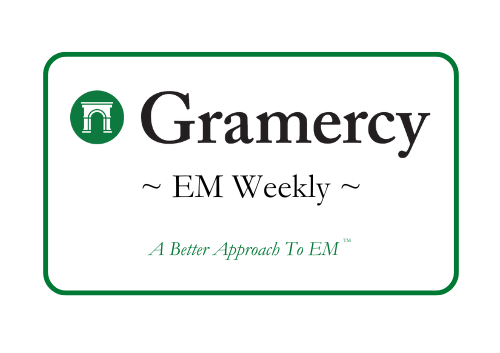Contents
Market Overview
Macro Update
This week, markets were driven by shifting U.S. policy signals, with volatility reflecting investor sensitivity to communications out of Washington. The tone was set by comments from President Donald Trump on Friday of the previous week, which appeared to question the Federal Reserve’s independence. On Monday, equities sold off, Treasury yields rose, and the U.S. dollar weakened to levels last seen in 2022—breaking several historical correlations. Gold surged to a record high of $3,494 amid the uncertainty. When White House officials clarified on Tuesday that the President did not intend to remove Fed Chair Jerome Powell, U.S. equities bounced back, the dollar regained strength, and Treasury yields edged lower. Risk assets rallied in response, with gold retreating from its highs and oil prices climbing. U.S. stocks are finishing the week in the green, with the S&P up 3.8%, the Nasdaq up 5.4% and the DJIA up 2.4%. Treasuries are ending the week relatively unchanged with the 10-year currently at 4.3%. After bear steepening on Monday, curves have flattened into the end of the week with the 2s and 10s currently at 48bps.
Shifting signals around trade policy added to the market’s bounce-back mid-week. President Trump floated the idea that a deal with China could result in lower tariffs, while also suggesting that new tariff rates for other countries could be announced in the coming weeks. This was met with conflicting signals from Chinese officials, who denied that formal negotiations were underway. The resulting ambiguity left investors grappling with a wider range of potential outcomes. In Europe, ECB President Christine Lagarde highlighted that the rerouting of global exports stemming from trade tensions could have disinflationary consequences for the region, further complicating the monetary policy backdrop.
The IMF Spring Meetings in Washington, D.C. this week contributed important context to the evolving macroeconomic outlook. The Fund lowered its global growth forecast and revised down the U.S. growth projection for 2025 from 2.7% to 1.8%, citing intensifying downside risks. It also raised the probability of a U.S. recession to 40%. In its commentary, the IMF emphasized that policymakers around the world now face increasingly difficult trade-offs between fiscal sustainability, economic re-acceleration, and rising spending pressures.
Economic data released during the week added to the mixed narrative. The April S&P Manufacturing PMI edged up to 50.7, suggesting modest expansion, while the Services PMI declined to 51.4, pointing to decelerating momentum in the larger services sector. Initial jobless claims rose modestly to 222,000, indicating continued labor market resilience but also raising questions about possible softening. Existing home sales declined 5.9% month-over-month, reversing gains from the previous report and hinting at further pressure on housing. On the consumer side, the University of Michigan sentiment index came in at 52.2, while one-year inflation expectations eased slightly, falling to 6.5% from 6.7%.
The Michigan survey shows that consumer sentiment fell to one of the lowest readings on record, and both short and longer-term anticipation of inflation marched even higher to a level last seen in 1991. This growing gap between soft and hard data could reflect a lag in the transmission channel between the two, or a bring-forward of consumption ahead of higher prices.
On the geopolitical front, attention turned once again to the war in Ukraine. President Trump called on President Volodymyr Zelenskiy to consider a peace deal with Moscow that would preserve Russia’s control over Crimea, a proposal that has drawn criticism for its potential long-term implications on sovereignty and the broader geopolitical order. Tensions escalated further following renewed Russian strikes on Kyiv, after which President Trump issued a rare public rebuke on social media, adding to the already elevated diplomatic noise.
EM Credit Update
EM hard currency sovereign debt posted a strong week, returning 0.8%, supported by a turn in risk sentiment mid-week. The high-yield segment led performance with a 1.0% return, outpacing the 0.6% return from investment-grade sovereigns. Sovereign spreads tightened by 9bps overall, driven by a 16bps tightening in high-yield, while investment-grade spreads tightened only 4bps.
Africa and Latin America drove sovereign returns, with high beta credits like Gabon, Kenya, El Salvador, Argentina, and Ecuador benefitting from better risk sentiment towards the end of the week. Pakistan was the top underperformer this week as tensions with India escalated following a terror attack in Indian-controlled Kashmir.
EM corporates lagged sovereigns slightly this week, delivering a 0.6% return. The high-yield segment led performance for corporates as well with a return of 0.7% vs. only 0.4% for investment grade. Corporate spread moves were like those of sovereigns, with overall spreads tighter by 8bps and led by a tightening in high yield of 13bps and investment grade of 5bps.
EM local currency sovereigns outperformed this week, returning 1.0%, supported by continued softness in the U.S. dollar.
Primary market activity remained muted this week with no sovereign issuance and 18 corporate issuers (13 of which were in Asia) tapping the market.
The Week Ahead
The week ahead will be heavy on data releases, although some may argue that the data is too backward-looking at this point to be of much relevance. Nonetheless, on Monday, the Dallas Fed Manufacturing Survey will provide a snapshot of regional factory activity. Tuesday brings the release of the FHFA Home Price Index, offering a view into housing market trends, along with the JOLTS job openings report. Wednesday is expected to be the most data-heavy day, with the first preliminary estimate of Q1 2025 GDP, the Employment Cost Index for the first quarter and the personal income and outlays reports, which includes the PCE Deflator – the Federal Reserve’s preferred inflation measure. Thursday brings initial jobless claims and ISM manufacturing, prices paid and new orders data. Friday will also be important with non-farm payrolls, the unemployment rate, average hourly earnings, and data on factory and durable goods orders. In China, the Caixin China PMI manufacturing data is set to be released on Tuesday. In the EU, the week will bring the ECB’s one- and three-year inflation expectations, consumer confidence numbers, GDP, and CPI results.
Fixed Income
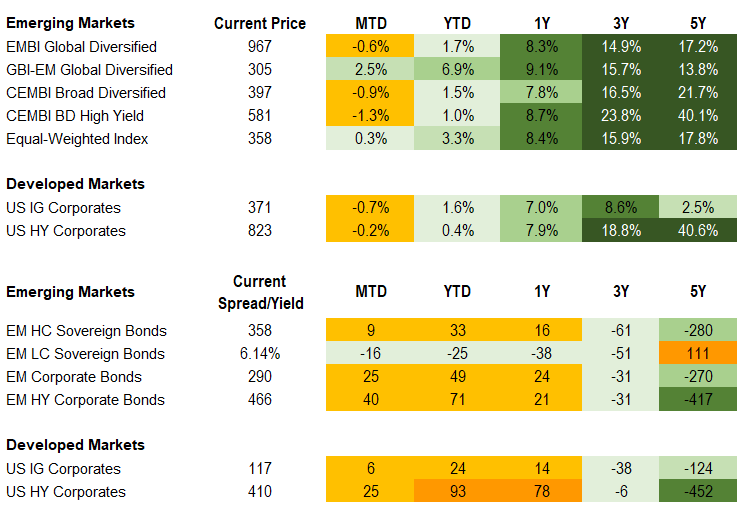
Equities
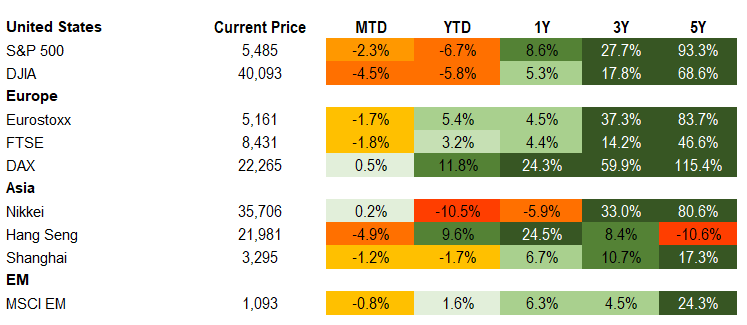
Commodities

Source for data tables: Bloomberg, JPMorgan, Gramercy. EM Fixed Income is represented by the following JPMorgan Indicies: EMBI Global, GBI-EM Global Diversified, CEMBI Broad Diversified and CEMBI Broad High Yield. DM Fixed Income is represented by the JPMorgan JULI Total Return Index and Domestic High Yield Index. Fixed Income, Equity and Commodity data is as of April 25, 2025 (mid-day).
Highlights
EM Corporates Choose Funding Certainty Amid Uncertain Backdrop
First quarter earnings are now underway, and the early reports speak to solid profitability and asset quality trends in the banking sectors of most countries. Those more severely hit by the pandemic and the subsequent inflation/rate hiking cycle are still enjoying a gradual rebound in asset quality and lending growth as particularly tight lending risk appetites have eased.
Brazilian steel producers have been struggling since 2023 with an increased number of cheap Chinese steel imports that pressure domestic prices. Companies such as Usiminas, CSN and Gerdau are among the most impacted. The current trade war poses additional risks to the Brazilian market due to potential trade diversion. Usiminas’ CEO, Marcelo Chara, mentioned this week during the Q1 2025 earnings call that visibility is low in the market, and if the Brazilian government does not increase protectionist measures in May, when the existent quota system is due to be revisited, the company will look to reduce their investment plan. Over the last months, other countries such as India have implemented new anti-dumping or temporary levies to deter increased imports.
Overall, lags of recent tariff shocks and potential impact on business and consumer confidence mean that the fundamental impact on corporate earnings will likely only be visible during the second half of the year, subject to progress on trade negotiations. In anticipation of what could be a more difficult backdrop during the second half of the year, issuers are opting for funding certainty over a wait-and-see approach.
As a result, this week saw a more material reopening of primary markets for emerging market corporates with issuance from a broad range of credits. After a short period of primary market closure, due to secondary market volatility, state-owned fertilizer producer OCP (Baa3/BB+/BB+, Morocco), private O&G Hunt Oil (Ba1/BBB, Peru) and high-quality subordinated financial Banco de Credito del Peru (Baa2/BB+, Peru) all successfully accessed the debt capital markets, though we note the increase in new issue concessions being paid (from c.0-10bps earlier in the year to c.10-30bps this week). We expect this theme to continue in the coming weeks.
IMF Lowers Global Growth Forecast with Material Downside Risks
Event: The IMF cut its estimate for 2025 and 2026 global growth by 50bps and 30bps to 2.8% and 3.0%, respectively, due to major policy shifts resetting the global trade system and giving rise to widespread uncertainty. The Fund’s report notes that “intensifying downside risks dominate the outlook”. In the current baseline, the EM-DM growth differential is set to ease slightly to 230bps from 250bps last year. In EM, Mexico and China saw the largest growth reductions of 170bps and 60bps to -0.3% and 4.0%, respectively. The forecast for U.S. growth was lowered by 90bps to 1.8%. Meanwhile, the market consensus and WTO world GDP growth estimates are 20bps and 60bps lower than the IMF forecasts for both 2025 and 2026.
Gramercy Comment: The relatively contained spillover of weaker U.S. growth and protectionist trade policy to the rest of the world can only be achieved if stimulus is effectively ramped up in Europe and China and initial parameters of the new global trade order emerge relatively quickly – with blocs of freer and fairer trade. Otherwise, we expect a much more sizable negative shock to global growth than the latest forecasts imply. More closed emerging markets economies with robust balance sheets should fare better than those with small open economies and limited policy space.
Emerging Markets Technicals
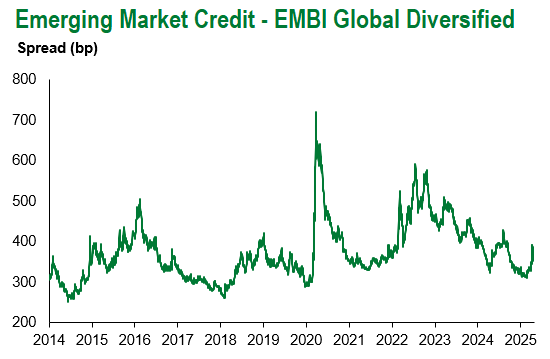
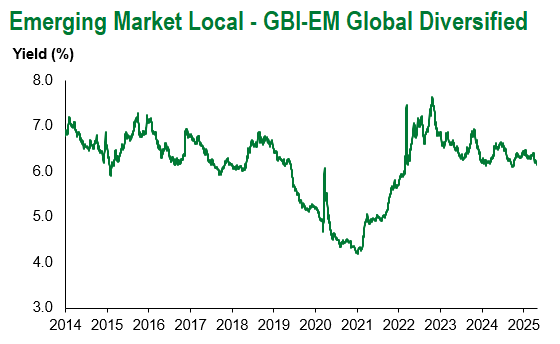
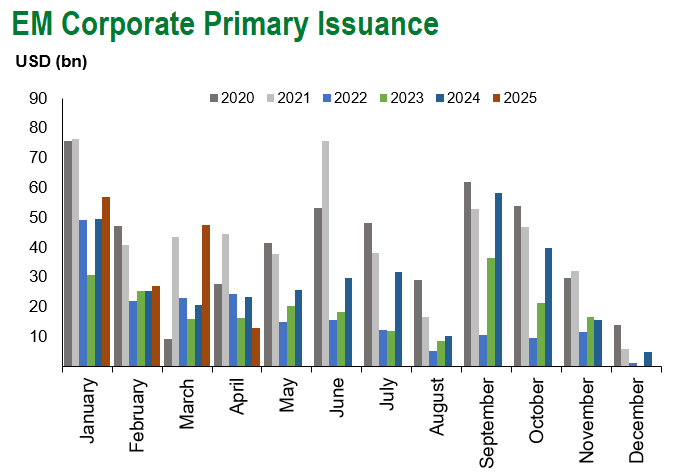
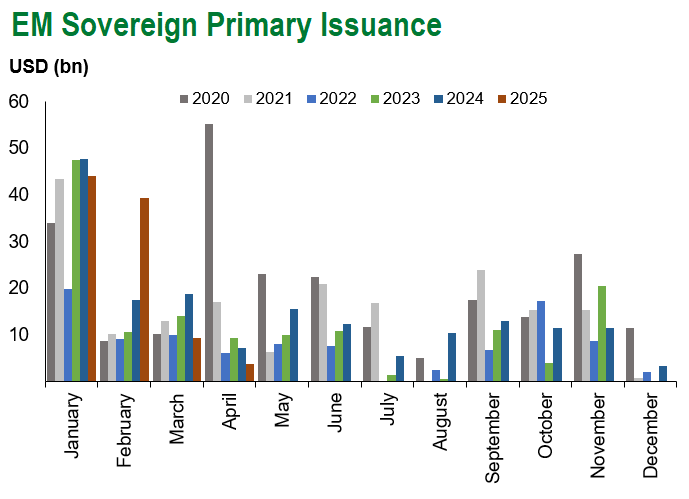
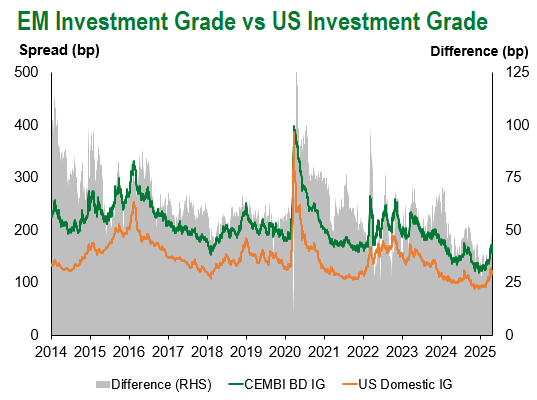
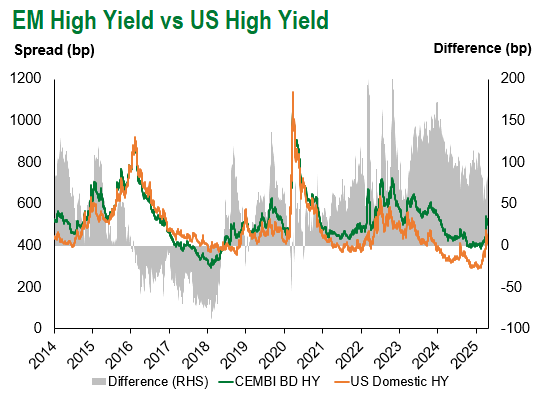

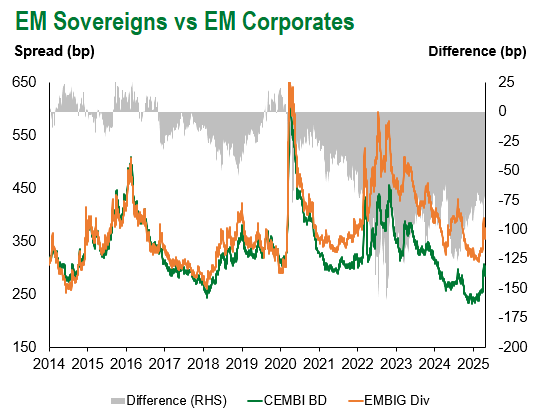
Emerging Markets Flows
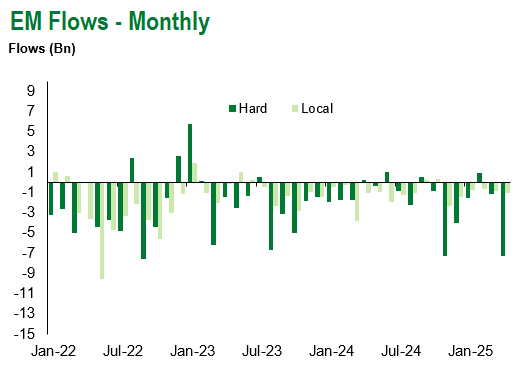
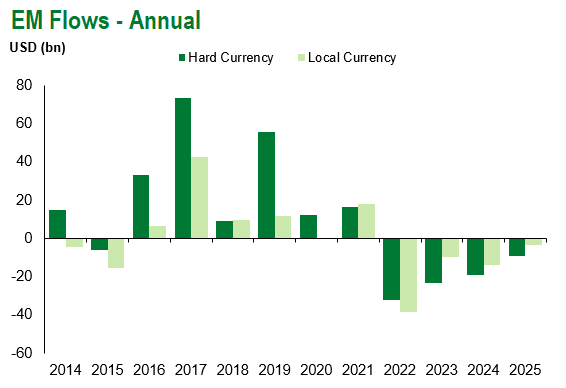
Source for graphs: Bloomberg, JPMorgan, Gramercy. As of April 25, 2025.
For questions, please contact:
Kathryn Exum, CFA ESG, Director, Co-Head of Sovereign Research, [email protected]
Petar Atanasov, Director, Co-Head of Sovereign Research, [email protected]
This document is for informational purposes only. The information presented is not intended to be relied upon as a forecast, research or investment advice, and is not a recommendation, offer or solicitation to buy or sell any securities or to adopt any investment strategy. Gramercy may have current investment positions in the securities or sovereigns mentioned above. The information and opinions contained in this paper are as of the date of initial publication, derived from proprietary and nonproprietary sources deemed by Gramercy to be reliable, are not necessarily all-inclusive and are not guaranteed as to accuracy. This paper may contain “forward-looking” information that is not purely historical in nature. Such information may include, among other things, projections and forecasts. There is no guarantee that any forecasts made will come to pass. Reliance upon information in this paper is at the sole discretion of the reader. You should not rely on this presentation as the basis upon which to make an investment decision. Investment involves risk. There can be no assurance that investment objectives will be achieved. Investors must be prepared to bear the risk of a total loss of their investment. These risks are often heightened for investments in emerging/developing markets or smaller capital markets. International investing involves risks, including risks related to foreign currency, limited liquidity, less government regulation, and the possibility of substantial volatility due to adverse political, economic or other developments. References to any indices are for informational and general comparative purposes only. The performance data of various indices mentioned in this update are updated and released on a periodic basis before finalization. The performance data of various indices presented herein was current as of the date of the presentation. Please refer to data returns of the separate indices if you desire additional or updated information. Indices are unmanaged, and their performance results do not reflect the impact of fees, expenses, or taxes that may be incurred through an investment with Gramercy. Returns for indices assume dividend reinvestment. An investment cannot be made directly in an index. Accordingly, comparing results shown to those of such indices may be of limited use. The information provided herein is neither tax nor legal advice. Investors should speak to their tax professional for specific information regarding their tax situation.
